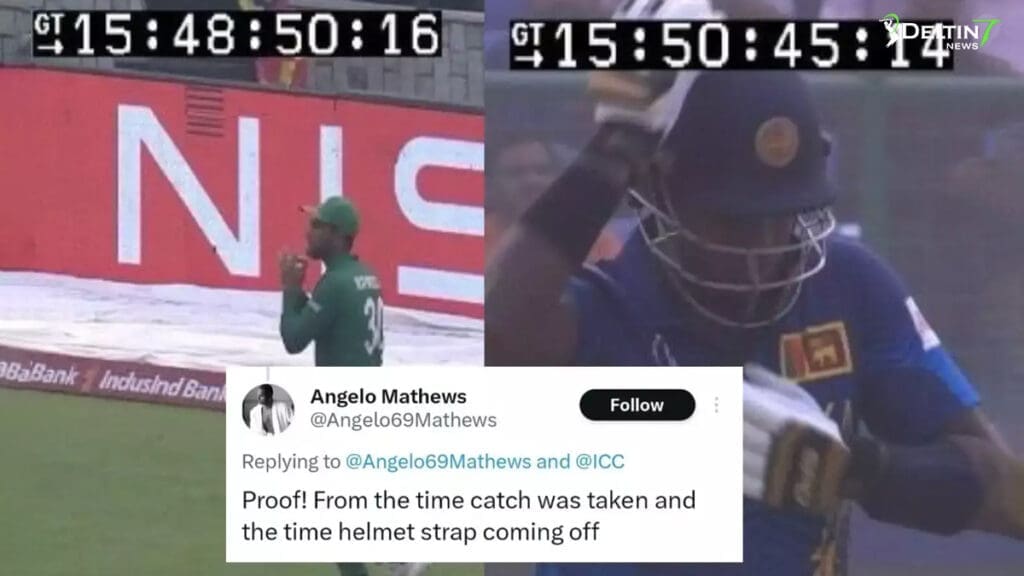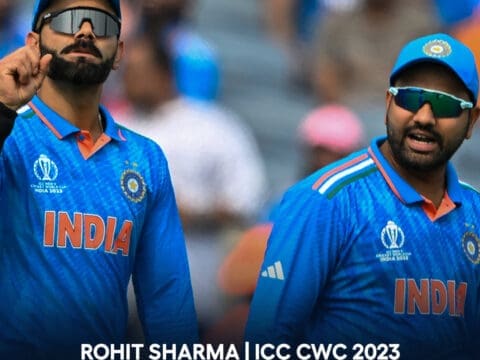
Angelo Mathews Video Evidence vs Fourth Umpire’s Version Fuels Timed Out Controversy
The day after the game, Sri Lanka’s Angelo Mathews shared a video on social media, complete with time stamps, that has ignited a controversy surrounding his timing-out during the match against Bangladesh. This controversy extended well after the conclusion of the match, with Mathews, a prominent Sri Lankan player, presenting video evidence on Tuesday that suggests he met the requirements to be on the pitch within the stipulated two-minute timeframe following the fall of a wicket.
Speaking to the media after a thrilling contest in which Bangladesh edged Sri Lanka by three wickets, Mathews asserted that he possessed visual evidence to support his claim that he had arrived at the center of the pitch within the required time frame. This crucial two-minute window is mandated for the next batsman to be prepared to take the strike after a wicket has fallen.
The day following the match, Angelo Mathews took to social media to share a video that depicted his actions on the field. This video, with embedded time stamps, appears to capture the moment he stood at the crease and gestured to the dressing room for a change of helmet, which was due to a broken strap. As per the video evidence, there were still five seconds left before he would have been ready to face the incoming delivery, based on the countdown timer. This was precisely when Bangladesh appealed for Mathews to be declared ‘timed out.’
However, the controversy doesn’t end with Mathews’ video. The fourth umpire for the match, Adrian Holdstock, who had a timer in his possession, shared his perspective on the matter with Star Sports on the day after the game. According to Holdstock, “In the instance this afternoon (sic), the batter wasn’t ready to receive the ball within those two minutes even before the strap became an issue for him.” This statement seems to indicate that, in Holdstock’s view, Mathews wasn’t prepared to face the delivery within the stipulated two-minute timeframe even before the helmet strap issue arose.
Contradicting this account, Mathews, relying on the video footage he had shared, maintains that the helmet strap malfunctioned with five seconds left on the clock. This is significant because the appeal for ‘timed out’ was initiated by Bangladesh at this point. Mathews also expressed his discontent with the umpires for failing to consult the third umpire to determine exactly when his helmet strap had malfunctioned, attributing the oversight to a lack of equipment regulation.
Understandably, Mathews was frustrated by the entire situation and expressed his concerns about player safety. He highlighted that wicket keepers, especially those facing spinners, are not allowed to keep without their helmets, emphasizing the importance of protective equipment. In his view, it was inconceivable that he could take his guard without a properly functioning helmet. Mathews’s perspective on the matter underscores the significance of ensuring player safety and equipment functionality.
In response to the controversy, Bangladesh captain Shakib al Hasan, who was at the center of the storm due to his appeal for a timed-out dismissal, defended his actions. In a post-match statement, Shakib claimed that one of his teammates had informed him about the relevant rule governing timed-out dismissals.
He said, “It is in the laws. I don’t know if it is right or wrong. But I felt like I was at war. I had to take the decision to make sure my team wins.” Shakib acknowledged the contentious nature of his decision but stressed the importance of ensuring that his team secured the victory. When asked how he would react if the situation were reversed, Shakib retorted, “I will be careful so that it doesn’t happen to me.” This comment reflects the competitive nature of international cricket, where every advantage is sought to secure a win.
While the video shared by Angelo Mathews appears to provide compelling evidence in his favor, the controversy surrounding this incident raises several unanswered questions. The video suggests that Mathews still had five seconds on the countdown clock when he reached the center of the pitch and requested a helmet change. Bangladesh was within their rights to appeal for a timed-out dismissal, given the established rules of the game.
However, the primary question that arises from this situation is why the umpires did not consider the equipment malfunction when making their decision. Did Mathews inform the umpires about his need to change the helmet due to the strap issue? According to the video shared by Mathews, it doesn’t seem like he communicated this information to the umpires, leaving room for confusion and debate. In conclusion, the controversy surrounding Angelo Mathews’ timing-out during the match against Bangladesh has stirred a considerable debate within the cricketing community.
The conflicting accounts and video evidence presented by Mathews and the fourth umpire, Adrian Holdstock, have cast a spotlight on the importance of equipment functionality, adherence to timing regulations, and the responsibilities of both the players and the umpires in such situations. This incident serves as a reminder of the complexities and intricacies involved in the game of cricket, where adherence to the rules and fair play is paramount.













